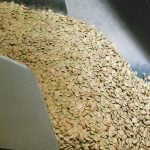Competition is heating up for Canadian pea producers.
Chuck Penner, senior consultant with Informa Economics, is particularly wary of the growth in U.S. yellow pea production and how that country’s exports are competing head-to-head with Canadian peas in India.
“We’ve had the luxury of having that marketplace largely to ourselves for a few years now,” said Penner.
Not anymore.
U.S. pea production was 80 percent greens and 20 percent yellows in the 1990s, but growers are now producing more yellows than greens.
Read Also

August rain welcome, but offered limited relief
Increased precipitation in August aids farmers prior to harvest in southern prairies of Canada.
Farmers grew an estimated 456,672 tonnes of yellows and 401,471 tonnes of greens in 2009 for a total of 858,143 tonnes. A decade ago they were producing one-quarter of that amount.
There has been a corresponding dramatic increase in exports, especially of yellow peas. The USA Dry Pea and Lentil Council forecasts 220,000 and 330,000 tonnes of green and yellow pea exports respectively in 2010. By contrast, the country’s biggest export year for yellow peas in the 1990s was 14,923 tonnes.
Penner thinks the surge in U.S. yellow pea exports could be contributing to the slow pace of Canadian pea shipments.
The Canadian Grain Commission reports that bulk pea shipments as of Jan. 17 are down 11 percent from last year despite having a nearly identical sized crop to move.
By contrast, the United States exported 110,000 tonnes of yellow peas during the first four months of the 2009-10 crop year, nearly double what was shipped in the same period last year. India has become a favourite destination for those peas.
The U.S. export volume pales in comparison to the millions of tonnes of peas Canada ships overseas annually, but it allows India to “shop around a bit” and fill five or six vessels from an alternative supplier.
“You don’t have to have a huge amount to take the edge off the market or take the top price off of the market,” Penner said.
He likened it to the competition Canada faces from Australia in red lentil markets.
Canadian pea growers didn’t used to worry about competition from their American counterparts because U.S. pulses were typically used in food aid shipments to Africa.
“That wasn’t markets that we were pursuing, so we could peacefully coexist,” Penner said.
However, the dramatic increase in pea production in states such as North Dakota means American exporters are now going after the same markets as Canadian companies.
Penner thinks U.S. growers could soon produce a million tonnes of the crop, especially in an environment of depressed wheat and durum prices.
However, he said the new competition is nothing to be feared.
“The market is large enough that we’re not going to be banging our heads on the ceiling anytime soon,” he said. “It’s not something that I view as a large threat, but it’s something to keep our eyes on.”















